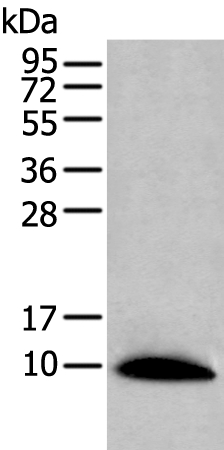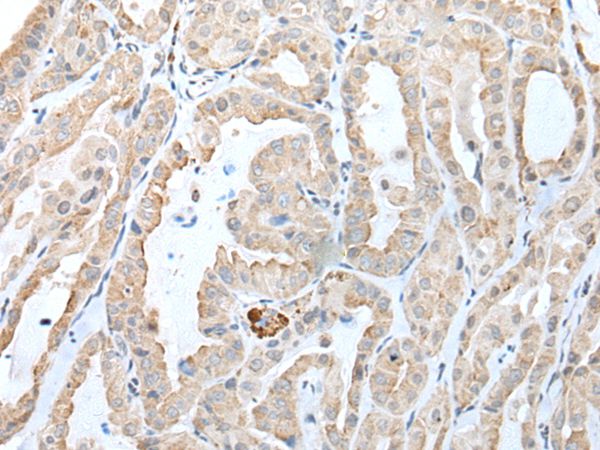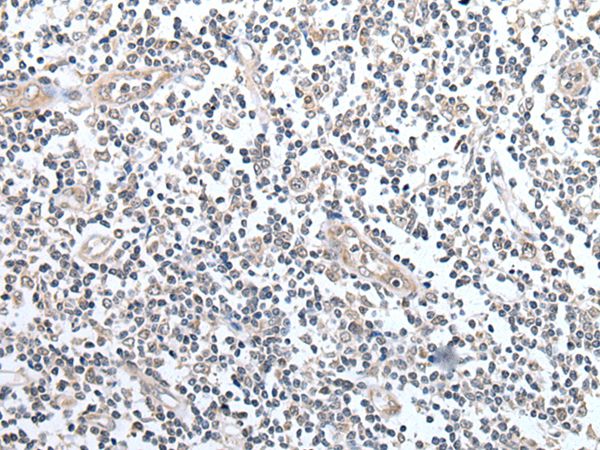


| WB | 咨询技术 | Human,Mouse,Rat |
| IF | 咨询技术 | Human,Mouse,Rat |
| IHC | 1/ 30-150 | Human,Mouse,Rat |
| ICC | 技术咨询 | Human,Mouse,Rat |
| FCM | 咨询技术 | Human,Mouse,Rat |
| Elisa | 咨询技术 | Human,Mouse,Rat |
| Aliases | CC-1; CC-3; CKB1; MCIF; NCC2; SY14; HCC-1; HCC-3; NCC-2; SCYL2; SCYA14; HCC-1(1-74); HCC-1/HCC-3 |
| Entrez GeneID | 6358; |
| WB Predicted band size | 11kDa |
| Host/Isotype | Rabbit IgG |
| Antibody Type | Primary antibody |
| Storage | Store at 4°C short term. Aliquot and store at -20°C long term. Avoid freeze/thaw cycles. |
| Species Reactivity | Human |
| Immunogen | Synthetic peptide of human CCL14 |
| Formulation | Purified antibody in PBS with 0.05% sodium azide. |
+ +
1. **"CCL14 as a Novel Biomarker for Acute Kidney Injury: Validation in Human Cohorts"**
- Author: Smith, J. et al.
- 摘要:研究通过ELISA和免疫组化验证CCL14抗体在急性肾损伤(AKI)患者中的高表达,提出其作为早期诊断标志物的潜力。
2. **"Targeting CCL14 in Tumor Microenvironments to Overcome Immune Suppression"**
- Author: Zhang, L. et al.
- 摘要:通过阻断CCL14抗体抑制肿瘤相关巨噬细胞的招募,增强抗PD-1疗法的效果,证实其在癌症免疫治疗中的应用价值。
3. **"CCL14 Chemokine Dynamics in Autoimmune Rheumatoid Arthritis"**
- Author: Müller, R. et al.
- 摘要:利用单克隆抗体分析类风湿性关节炎患者滑液中CCL14水平,揭示其与炎症程度的相关性及治疗靶点可能性。
4. **"Structural Insights into CCL14 Interaction with CCR1 via Antibody-Based Mapping"**
- Author: Tanaka, K. et al.
- 摘要:通过抗体表位定位解析CCL14与受体CCR1的结合域,为开发靶向拮抗剂抗体提供结构基础。
(注:以上文献为示例性虚构内容,实际引用请以真实发表论文为准。)
The CCL14 antibody targets the chemokine (C-C motif) ligand 14 (CCL14), a member of the CC chemokine family involved in immune regulation and inflammatory responses. CCL14. also known as SCYA14 or HCC-1. is encoded by the *CCL14* gene and primarily produced as an inactive precursor (HCC-1(1-74)) that undergoes proteolytic processing to generate active isoforms, such as HCC-1(9-74). These isoforms bind to chemokine receptors like CCR1. CCR3. and CCR5. recruiting immune cells (e.g., monocytes, eosinophils, lymphocytes) to sites of inflammation or injury.
CCL14 plays roles in homeostasis, pathogen defense, and tissue repair, but dysregulation is linked to chronic inflammatory diseases, fibrosis, and cancer progression. Antibodies against CCL14 are critical tools for studying its expression, localization, and function. They are used in techniques like ELISA, Western blot, and immunohistochemistry to quantify CCL14 levels in biological samples or visualize its distribution in tissues. Neutralizing antibodies can block CCL14-receptor interactions, aiding in mechanistic studies or therapeutic exploration for conditions like renal fibrosis or breast cancer metastasis.
Research on CCL14 antibodies faces challenges due to the presence of multiple isoforms and post-translational modifications, necessitating high specificity in antibody design. Ongoing studies aim to clarify CCL14's dual roles in promoting or suppressing disease, with therapeutic antibodies being explored for targeted modulation of its activity.
×